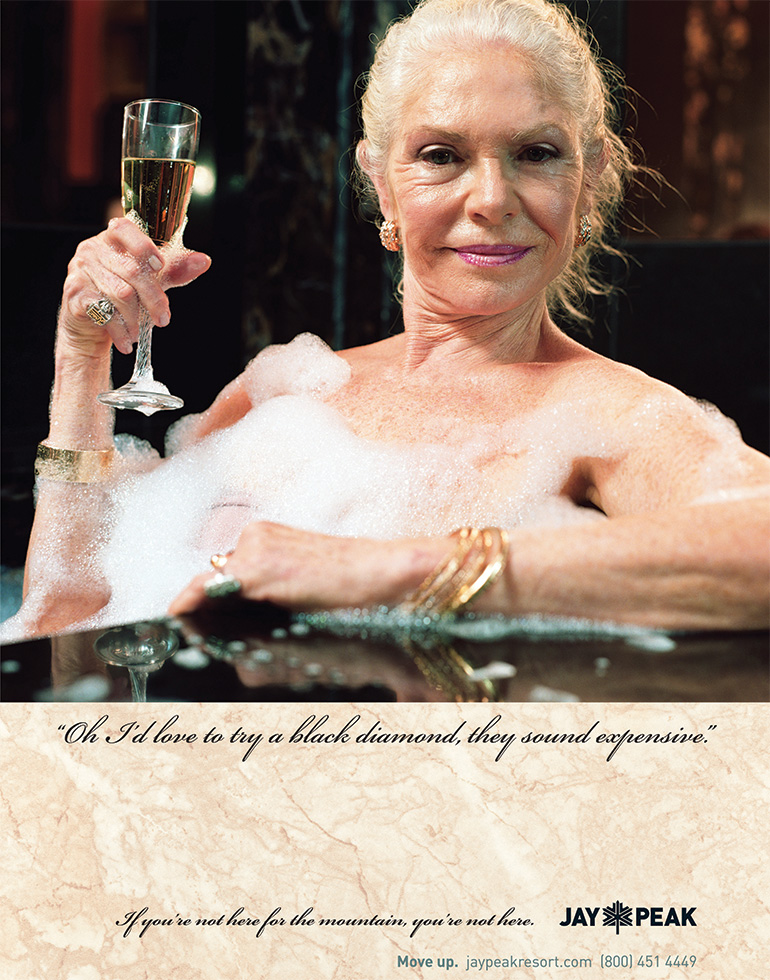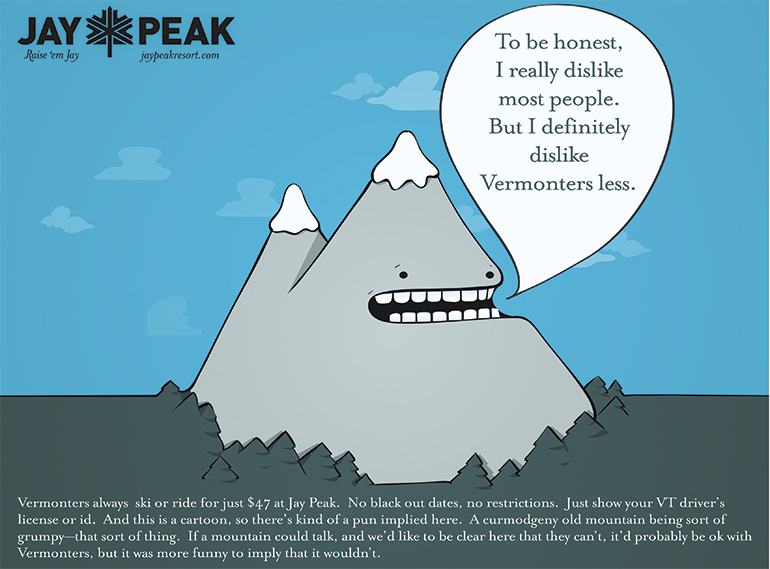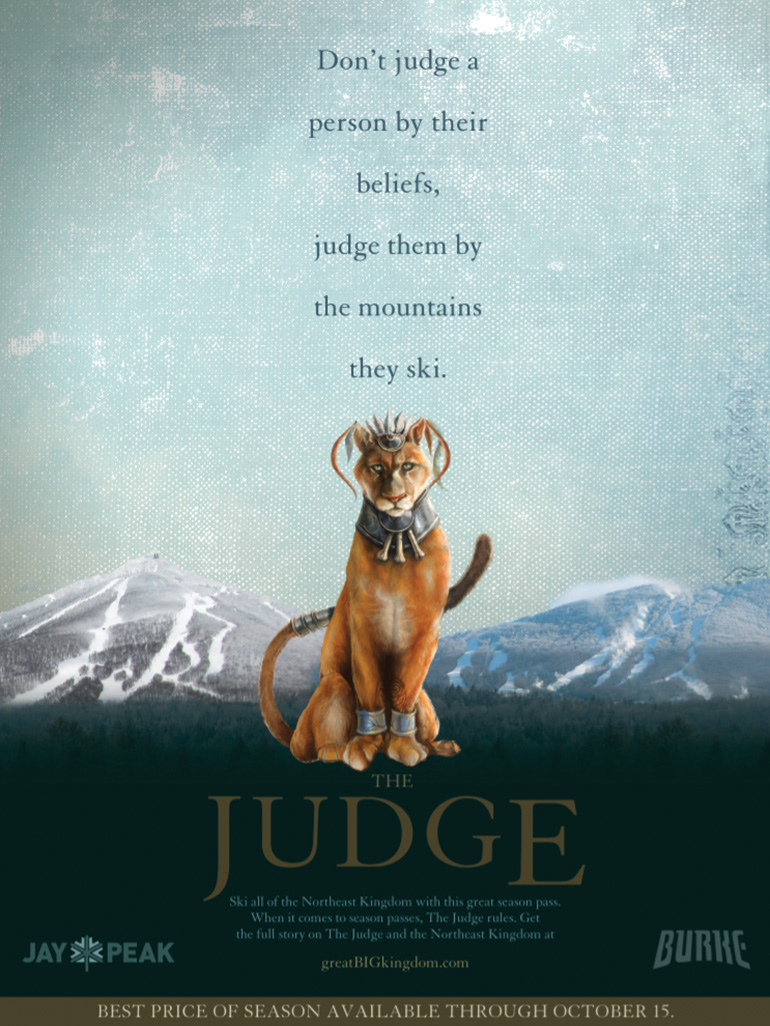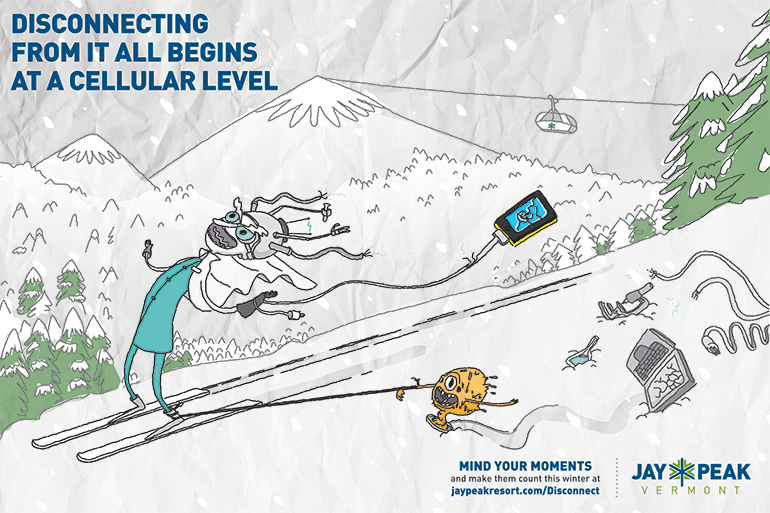Failure is not an option. As sayings go, this is about as hardcore as they come. It’s a great mantra if in your daily life you say things like, “Meet me in the Situation Room” or “We jump at zero-dark thirty.” But in the world of ski resort marketing, failure can be a semi-regular and less consequential occurrence.
At Jay Peak Resort, it’s not only an option—though one not actively pursued—but something regarded as an opportunity. And it’s part of a company culture that’s led to 15 National Ski Areas Association nominations for Best of Marketing awards along with more than a half-dozen wins, two best-of nods for Creative Marketing in Tourism from the Vermont Tourism Summit, nine Best-of Marketing awards from the World Waterpark Association, and a few atta-girl’s from this very publication.
Actively trying to avoid failure can drastically restrict creativity. That’s a dangerous approach to take in any marketplace. Vying for the eyes and ears of consumers has become exceedingly difficult. You need to stand out. And to stand out, you can’t be timid.
Jay Peak hasn’t been timid, with either its campaigns or its self-assessments of them. That’s how it turns failure into opportunity. Here’s how CMO and GM Steve Wright and I see it.
JJ TOLAND: SAM asked us to talk about Jay Peak’s marketing failures. Seems like fertile ground.
STEVE WRIGHT: Are we talking about just campaign-related failures right now, or the world of our failures in general?
JJ: We only have about 2,000 words, so let’s just focus on campaign failures. Let’s start with the one in 2008, when we were about to launch a $500-million revitalization initiative designed to allow us to grow. And rather than celebrate it, we sort of apologized for it.
STEVE: The real problem there was that we knew growth was coming, and I just didn’t embrace it—either willfully or unconsciously, I can’t remember, but it doesn’t much matter. Jay was always known for being flush with snow but thin on amenities. People came here to ski and ride. We had one small hotel (the original Hotel Jay), and that’s about it.
That was all about to change. Even knowing it was coming, we started a campaign with the tag of, “If You’re Not Here for the Mountain, You’re Not Here.” We were telling people to only focus on the mountain, highlighting that we have absolutely nothing else for them to do here, all the while knowing that we were about to become the very kind(ish) of experience we were mocking in that campaign.

 NOT THE BEST IDEA: Although marketers knew Jay Peak would soon begin a $500 million revitalization, their “If you’re not here for the mountain, you’re not here” campaign (facing page and here) mocked experiences similar to those the resort would soon offer. That was less than helpful from a long-term perspective.
NOT THE BEST IDEA: Although marketers knew Jay Peak would soon begin a $500 million revitalization, their “If you’re not here for the mountain, you’re not here” campaign (facing page and here) mocked experiences similar to those the resort would soon offer. That was less than helpful from a long-term perspective.
We marginalized all of the vacation elements that didn’t connect to being on the mountain. By taking that stance, we set ourselves up to be knowingly disingenuous somewhere down the road. Tough to get much dumber than that.
I was the person responsible for preparing us, with respect to messaging, for the changes that come from investing nearly half a billion dollars at the resort, in the event we actually went through with it. I failed at that. Why? I listened and reacted too deliberately to the vocal minority, which had already come under the Jay Peak tent and didn’t want anything about what they had found to change. It’s a trap that’s easy to fall into and, in doing so, you miss the opportunity to tell a better story to a bigger audience and expand your impact.
I’ll never be the person to tell you to disregard the vocal minorities in the audience—at Jay Peak they’re part of the foundation of who we are (and close to being vocal majorities)—but your marketing needs to not only drive business today, it needs to set you up for success multiple years down the road. I think that’s something that’s easy to forget.
JJ: It sounds like a lot of our campaigns in the initial years of the expansion were all about us apologizing for what we were doing?
STEVE: Right. We used an entire campaign (“At the Heart of Change Beats the Unchangeable”) to tell people that despite our growth, we weren’t changing. Never mind that an overwhelming index of people seeing these messages had no idea what we were talking about, and those that did weren’t being introduced to what we were adding and how they may benefit from it.
JJ: So we missed out on saying how we’re different. Still, the creative in our campaigns is consistently different.
STEVE: I think a good campaign has to punch through an awful lot of noise, especially nowadays. We had no problem punching, but likely had some issues landing them where we wanted to.
JJ: What campaign(s) didn’t deliver a punch?
STEVE: Go back to “If You’re Not Here for the Mountain.” It punched through the noise, but it didn’t put us in a position to leverage all of the assets we were going to build. Being stuck in this apologetic mindset handicapped our ability to address a wider audience and potentially bring in more people sooner. We wound up putting ourselves in a corner, and drew too hard a line about who we were and who we weren’t.
And then once we did build everything and the waterpark was open, we were still afraid to talk about it. The “At the Heart of Change” campaign ran the year we opened the Pump House indoor waterpark. We were still talking about how we’re not changing, and we just cut the ribbon on a 60,000-square-foot indoor waterpark at the base of the mountain. We still cared too much about the unchangeable. We still cared too much about pleasing that minority.
The greatest service we could have done for that minority and the cohort of people who have been here for 20-30 years is to create a solid business that allows for us to continue to treat that group well, even with different assets around them.
JJ: How might we have blended the unique voice we’ve developed into ads that would bring in a wider audience?
STEVE: We could have spoken to both audiences using a similar tone, something that felt unmanufactured, but without shying away from the new assets. We could have used language to connect the old and the new rather than create a dividing line between what we had been and what we were becoming.
We might have said something like, “The mountain’s not changing, and we’re not sorry about wanting to have a bright future, and here’s how we’re doing that.” I should have focused more on the special thing about Jay Peak, which is the relationship we have with our guests. And adding a hotel with actual pillows and carpets isn’t going to undo that. That sentiment came in eventually, but too late to make a fast difference.
JJ: How’d you get to that epiphany?
STEVE: Same way I get to most of my epiphanies—I listened to someone else. Kim Hewitt, Jay Peak’s marketing director, started to say, “What are we doing here?” And it was through her pushing and good conversations with smart people at Origin (the resort’s ad agency) and Stephan and Brady (the agency that handles media buying) and other smart people that we listen to that we began to find that edge, where you can talk to both your hard-core and the broader market.
 WHO ARE WE TALKING TO? WHY? In 2008, Jay Peak was about to undergo unprecedented capital improvements, but focused on speaking to its core, vocal minority in its marketing campaign, rather than its soon-to-be growth audience. Here, a print ad that was part of the “If you’re not here for the mountain, you’re not here” campaign, aimed at a small subset of its core: Vermonters.
WHO ARE WE TALKING TO? WHY? In 2008, Jay Peak was about to undergo unprecedented capital improvements, but focused on speaking to its core, vocal minority in its marketing campaign, rather than its soon-to-be growth audience. Here, a print ad that was part of the “If you’re not here for the mountain, you’re not here” campaign, aimed at a small subset of its core: Vermonters.
JJ: Let’s shift from the technical/tactical end of things back to the creative. When I started here you said, “It’s alright to have an idea that fails because maybe you were pushing too far in the wrong direction, but fail as fast as you can, then course-correct before you’ve lost too much money.”
STEVE: When you’re in the idea phase of a campaign, at least for me, it’s about the marketing and stories that I respond to. You have to be careful with that frame of mind, because your ultimate obligation is to the viability of the business, not necessarily your true marketing self. Many times those two things don’t line up. If you wind up shaping a narrative that only appeals to a certain type of person and ignores, say, 75 percent of the rest of your potential market, you’ve lost. Or, at best, you’re losing.
JJ: Was “The Judge” campaign a loss? (The Judge campaign was designed to sell a combination pass to Jay Peak and Burke Mountain. It had as its anchor image a giant catamount done up to look like some sort of cabaret version of an Egyptian deity with metallic dreadlocks, sent from the beyond to re-unite Burke and Jay Peak.) What was the sober thought process behind that creative?
STEVE: Yeah, I loved it. I thought the story that was written about it, the fable that was told, was really good. I loved having a character that represented the Northeast Kingdom [the rural region of Vermont where Jay Peak and Burke are located] at the center of a narrative of why the two resorts were split up and why they were coming back together.
 FIRST, SELL IT INTERNALLY! “The Judge” campaign was designed to market a combined Burke-Jay Peak pass, and was primed for success. Not enough was invested into selling the concept internally, though. Ownership at the time didn’t get it, and the campaign got nixed.
FIRST, SELL IT INTERNALLY! “The Judge” campaign was designed to market a combined Burke-Jay Peak pass, and was primed for success. Not enough was invested into selling the concept internally, though. Ownership at the time didn’t get it, and the campaign got nixed.
We wanted to create the story, and then off of that story build assets that showed the two mountains coming together, and ultimately highlighting the value in buying a pass that got you access to two mountains that collectively had invested close to half a billion dollars in improvements.
But we didn’t put enough money into telling the story. Our owner at the time hated it—actually didn’t understand it—so we had to discontinue it. I don’t look at The Judge campaign as a failure of concept, but rather a failure of internal communications.
JJ: You think if we had put money in it, The Judge would have succeeded?
STEVE: Absolutely. I look back on that website and that story that was written, along with the accompanying visuals, as being really good. It’s right up there with the best of what we’ve done. But it never got light because I didn’t understand the approval channels. And that’s on me.
If you’re in charge of the creative, then you’re in charge of understanding the chain of approval and getting to ‘yes.’ That’s it.
JJ: Is there a campaign you regard as a creative failure, one that in retrospect you wish you had done differently?
STEVE: The Disconnect one we did in 2014-15, where we talked about the need to disconnect from technology and connect with one another. It wasn’t necessarily a failure. It was just a message that was starting to be used by other markets and organizations, and it never really developed into a campaign. It was a print ad. That’s it.
 FAILURE TO DIFFERENTIATE: The “Disconnect” print ads ran when that general message was being used by many other companies in a variety of different consumer markets. Since the idea was being so widely used, it failed to differentiate Jay Peak, and as a result, it never grew into a cohesive, omnichannel campaign.
FAILURE TO DIFFERENTIATE: The “Disconnect” print ads ran when that general message was being used by many other companies in a variety of different consumer markets. Since the idea was being so widely used, it failed to differentiate Jay Peak, and as a result, it never grew into a cohesive, omnichannel campaign.
JJ: Take any lessons away from that one?
STEVE: Good work takes time to develop. And the difference between a good set of print ads, or TV spots, or a good paid search strategy versus a coordinated marketing campaign is meaningful. If it’s done correctly, it makes the campaign feel a lot broader than it actually is. Making sure there’s a common creative or language thread running through everything—print, digital, PR, OOH, electronic, merchandising—adds depth and thoughtfulness to your messaging in a way that simply buying space and impressions definitely does not. People don’t talk about a campaign because they’ve seen it a lot. They talk about it, generally, because it’s thoughtful and they connect with it on some level of emotional resonance.
JJ: What’s your gut on our current campaign? Did we learn from our mistakes?
STEVE: The “We’re Us Because You’re You” campaign feels like it’s working to me. It’s meant as a thank you to the various groups that have supported us through our receivership. And that message extends past print and TV ads and into programming designed to thank our employees, our vendors, our guests, and our communities. Extending the campaign into the programming is really where you can make a difference, both with respect to how people see you as well as bottom-line related performance.
Extending your campaign into the smaller corners of your business can be time consuming, and you could justify that it has a much smaller impact in terms of audience, but for those people you do reach—the people that read the marginalia in your magazine, or on a Do Not Disturb sign in the hotel, a bar coaster or your to-go sandwich packaging—it leaves an impression that lasts. As a marketer, that’s what you’re looking for. That’s what we’re looking for, at least.
JJ: So, failure is a good thing.
STEVE: On the surface it obviously sucks, but to the extent it stays with you, and leaves an impression, it creates a good opportunity to do something better. If you’re going to put yourself out there creatively, you’re going to fail. It is what it is. Just don’t fail at the same thing twice.






